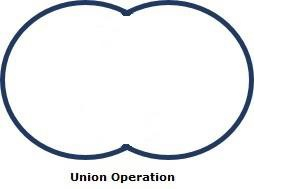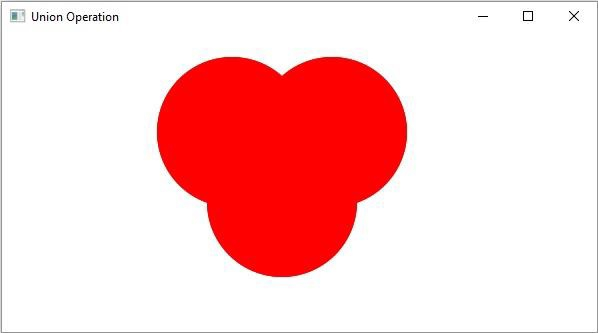
 Data Structure
Data Structure Networking
Networking RDBMS
RDBMS Operating System
Operating System Java
Java MS Excel
MS Excel iOS
iOS HTML
HTML CSS
CSS Android
Android Python
Python C Programming
C Programming C++
C++ C#
C# MongoDB
MongoDB MySQL
MySQL Javascript
Javascript PHP
PHP
- Selected Reading
- UPSC IAS Exams Notes
- Developer's Best Practices
- Questions and Answers
- Effective Resume Writing
- HR Interview Questions
- Computer Glossary
- Who is Who
Explain the Union operation on 2D shapes in JavaFX
This operation takes two or more shapes as inputs and returns the area occupied by them combined as shown below.

The union() (static) method of the javafx.scene.shape.Shape class accepts two Shape objects and returns the result of the union operation of the given objects.
Example
import javafx.application.Application;
import javafx.scene.Group;
import javafx.scene.Scene;
import javafx.scene.paint.Color;
import javafx.stage.Stage;
import javafx.scene.shape.Circle;
import javafx.scene.shape.Shape;
public class JavaFXUnionExample extends Application {
public void start(Stage stage) {
//Drawing circle1
Circle circle1 = new Circle();
circle1.setCenterX(230.0f);
circle1.setCenterY(100.0f);
circle1.setRadius(75.0f);
circle1.setFill(Color.DARKRED);
//Drawing Circle2
Circle circle2 = new Circle();
circle2.setCenterX(280.0f);
circle2.setCenterY(170.0f);
circle2.setRadius(75.0f);
circle2.setFill(Color.DARKRED);
//Drawing Circle3
Circle circle3 = new Circle();
circle3.setCenterX(330.0f);
circle3.setCenterY(100.0f);
circle3.setRadius(75.0f);
circle3.setFill(Color.DARKRED);
//Union operation
Shape union = Shape.union(circle1, circle2);
union = Shape.union(union, circle3);
union.setFill(Color.RED);
//Setting the stage
Group root = new Group(circle1, circle2, circle3, union);
Scene scene = new Scene(root, 595, 300);
stage.setTitle("Union Operation");
stage.setScene(scene);
stage.show();
}
public static void main(String args[]){
launch(args);
}
}
Output


Advertisements
